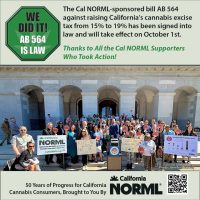Opponents of this November’s Prop 19 initiative are blowing hot air about the supposed impacts of marijuana legalization on highway safety.
The opposition has shrewdly named itself Public Safety First, in line with opinion polls that show driving under the influence of marijuana is a major public concern.
Opponents have lined up the support of Mothers Against Drunk Driving, which stated, “we are deeply concerned (the initiative) will result in more impaired driving and thus more injuries and fatalities.”
Fortunately, however, a careful review of the scientific evidence shows that fears about marijuana’s impact on road safety are unwarranted. A succession of studies over the years have consistently found that marijuana – in marked contrast to alcohol – has remarkably little impact on highway safety. In the most recent driving study, researchers at Hartford Hospital and the University of Iowa found that drivers on marijuana scored nearly identically on driving simulator tests to drug-free drivers.
Repeated surveys of fatal accidents involving tens of thousands of drivers have found that those with marijuana only in their blood are on average no more dangerous, and in many cases safer, than those with low, legal levels of alcohol (beneath .08% alcohol in blood, the threshold for DUI). See a summary of studies.
The major exception is when marijuana is combined with alcohol, which tends to be highly dangerous.
In contrast, marijuana-only drivers have been found in several studies to be no more dangerous those with no drugs at all. The reason appears to be that marijuana tends to make users drive more slowly, while alcohol makes them speed up. To the extent that legalization encourages the substitution of marijuana for alcohol, it might therefore be expected to improve traffic safety; on the other hand, this could be offset if there were an increase in the combination of the two together.
The dangers of legalization are dramatically overstated in an unpublished report by Al Crancer, a retired NHTSA researcher, who claims that legalization could cause a tripling in marijuana-caused accidents. Ironically, Crancer is famous for having authored a 1969 study showing that marijuana had no evident effect on driving performance. While he still believes that marijuana is safer than alcohol, he argues that the combined use of marijuana and alcohol has surged dangerously in California.
Citing data from the federal government’s FARS accident reporting system, Crancer points to a recent doubling in the incidence of marijuana in fatal drivers in California. The number of fatal drivers with THC in their blood jumped from 2.7% in 2003 to 4.5% in 2004 and reached 5.5% in 2008 (blood tests typically register the presence of THC for a couple of hours in occasional users, or up to 48 hours or more in regular users). About half of the fatal drivers are also legally above the limit for alcohol.
Crancer inexplicably attributes this jump to the legalization of medical marijuana, which he misdates to 2004. In fact, though, medical marijuana was legalized in 1996, while the recent explosion of pot clubs in Los Angeles and Southern California didn’t occur until 2006-7. The rise in marijuana-related accidents therefore has no obvious relation to any change in the legal availability of marijuana.
A further look at Crancer’s data from other states debunks the notion that California’s liberal laws are a significant cause of accidents. Compared to other states, California ranks 14th in the nation in the rate of marijuana involvement in fatal accidents at 5.5%. Significantly, this is substantially below that of several states with notably tougher marijuana laws, including South Carolina (7.8%), Indiana (8.4%), Missouri (6.9%) and New Hampshire (14.1%), which ranks highest in the nation.
A county-by-county breakdown of marijuana-related accidents in California shows no evident pattern. The highest rates (over 16%) occurred in rural counties: Modoc, Del Norte, Yuba, San Luis Obispo, Inyo, Placer, Mendocino, and Humboldt; only the last two of these are known for liberal marijuana enforcement. In contrast, zero (0%) accidents were reported in San Francisco and Santa Cruz, two of the most marijuana-friendly counties in the state Alameda County, the home of Oaksterdam, was sligihtly below the state average at 5.1%, while Los Angeles, the state’s largest county, was above average at 6.8%.
Crancer arbitrarily assumes that legalization would cause marijuana involvement in fatal accidents to triple. However, studies have repeatedly failed to find any relation between liberal marijuana laws and increased usage. Despite having the most liberal access to marijuana in the nation, California ranks only slightly above average in marijuana usage, behind 16 other states and the District of Columbia, according to government surveys.
In the Netherlands, where marijuana is legally available to all adults, usage is less than in many other European countries and only half that in the U.S., according to the European Monitoring Centre for Drugs and Drug Addiction.

Historically, no increase in accident rates was observed following the widespread popularization of marijuana in the late 1960s, when usage soared from next to nothing to tens of millions of users. As shown in the graph above, accident rates have consistently declined since records were kept, right through the period when marijuana reached its peak popularity in 1980. Indeed, only a modest, transitory blip in auto accidents occurred after alcohol prohibition was repealed (even though drunken driving is a leading highway hazard, DUIs were not a major issue in prohibition repeal).
All of this suggests that the legal availability of intoxicants has little bearing on on-the-road accident safety. It might be concluded that DUIs are caused by a minority of irresponsible thrill seekers, whose behavior is generally impervious to legal sanctions. The persons most likely to become new users of marijuana after legalization would be those who are more law-abiding and responsible, and who would accordingly be less likely to cause DUIs than current illegal users.
A second bogus safety concern raised by the opposition has to do with workplace safety. The initiative includes a clause that limits arbitrary drug testing, saying no person can be “punished, fined or discriminated against” for using marijuana. However, it goes on to state that employers retain “the existing right … to address consumption that actually impairs job performance”
Overlooking this clause, business interests, including the California Chamber of Commerce and bus industry, have attacked the initiative on the grounds that it would impair workplace safety.
“All of our employees are screened and trained to the highest safety levels possible and this includes the employees who maintain these motor coaches so that they operate in a safe manner. said Dan Eisentrager – West Coast Region Vice President for the CoachAmerica bus company. “This initiative would subject millions of California bus riders, every day, to unsafe and potentially fatal consequences ….”
In fact, the initiative would in no way alter California’s laws against driving under the influence, nor would it override federal regulations mandating random drug testing of transportation workers, nor would it limit employers’ right to test for on-the-job marijuana impairment. Furthermore, there is no good scientific evidence that drug testing improves workplace safety in the first place.
–Dale Gieringer, Cal NORML



